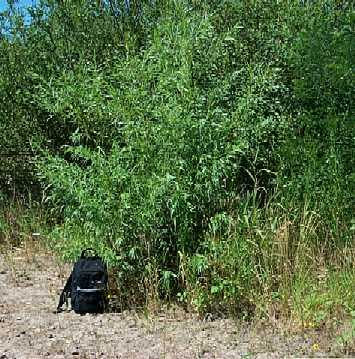
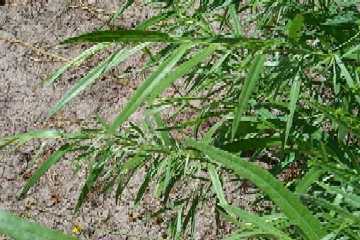
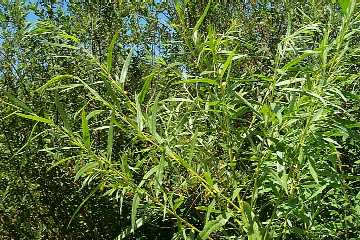
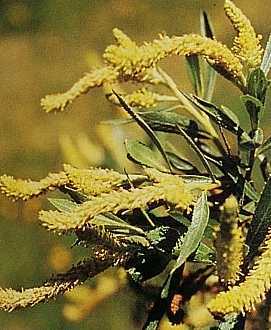
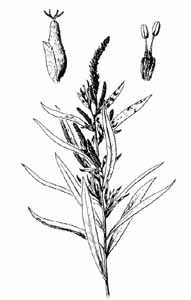
General Species Description.
- Columbia River willow is a multi-stemmed, compact shrub which grows two to six meters tall. The main trunk can be up to 100 centimeters thick, however, it is more commonly a spreading shrub with many stems. New twigs are covered with loosely appressed, forward-pointing hairs. Mature twigs are smooth and/or occasionally waxy. Older bark is gray-brown and scaly. Most plants are male. The twigs seldom have galls, which are swollen growths on leaves or stems resulting from insect larvae in the gall.
Leaves
- Leaves are brown or green and copiously covered by loosely appressed, forward-pointing hairs. When mature they are smooth and/or occasionally waxy. Leaves are variable but usually elliptic to lance shaped. Margins have small, forward-pointing gland-tipped teeth. Occasionally they are smooth-margined.
Inflorescence/Flowers
- Blooms occur June through July. Catkins appear mostly after but sometimes with the leaves. Male catkins are three to five centimeters long and four to six millimeters wide. There are two stamens, filaments densely hairy toward the base, and two glands of unequal size. Female catkins are four to ten centimeters long and oval shaped. There are dense, usually persistent, forward-pointing, slightly bent hairs. There is one stipe which is 0.5 millimeters long, and one stigma which is forked. There is one gland, tapering from the base. The stipe is short. The floral bracts are yellow, very hairy, and eventually deciduous. They are generally oblong-lance-shaped and often widest near the rounded, or slender-pointed tip.
Habitat
- Columbia River willow is often found in sandy habitats above the water level. It colonizes by rooting shoots. The established plants often survive being deeply buried. It is often found with Sitka willow (Salix sitchensis) and soft-leafed willow (Salix sessilifolia). It grows in gravelly substrates in the Willamette Valley.
Range
- Common along sandy banks of the Columbia River west of Portland, Columbia river willow is found as far south as Lynn and Lane Counties in Oregon, but not farther north than southern Washington. According to the Hitchcock and Cronquist text, it is found on the banks of the Columbia River from the mouth of the Deschutes River to the mouth and lower few miles of the Willamette River.
Similar Species
- Columbia River willow commonly hybridizes with sandbar willow and soft-leafed willow. Neither of these have leaves with forward-pointing hairs. Soft-leafed willow also has hairy capsules and forked stigmas, but the leaves are only three times as long as wide. The female catkins of sandbar willow are smooth or only slightly hairy.
Ecological Value
- In general, willows are highly favored by wildlife in this area. Willow buds are eaten by birds and small mammals. Deer and elk eat the twigs and leaves. Rabbits, mice and beavers eat the bark. Beavers use willows to build their dams. Willows are often the dominant stream bank plants where they prevent erosion by stabilizing the banks and providing nesting habitat for birds and mammals. Willows also shade stream banks, enhancing fish habitat. Willow leaves provide a food source for aquatic bacteria during the fall and winter. The decaying leaves provide nutrients for the aquatic food chain.
Human Value
- In general, willows are used for ornamental plantings near water sources. They bloom early, can be used as shade trees, and the "pussy willows" (unopened male catkins) are used for decoration. Mecerated willow wood contains a plant hormone that stimulates root growth. Native people of western Washington and Oregon used willow wood for construction and fibers were used for fishing and hunting.
References
- Cooke, S. S., ed. 1997. A Field Guide to the Common Wetland Plants of Western Washington & Northwest Oregon.
Seattle Audubon Society and Washington Native Plant Society. Seattle Audubon Society, Seattle WA, 66 p.
Hitchcock, C. L. and A. Cronquist. 1973. Flora of the Pacific Northwest. University of Washington Press, Seattle WA, 67 p.
This page was created by: Marshall Johnson, August 8, 2000
Return to Northwest Oregon Wetland Plants Project